| Article ID | Journal | Published Year | Pages | File Type |
|---|---|---|---|---|
| 8876963 | Mathematical Biosciences | 2018 | 24 Pages |
Abstract
We find that decreasing the basic reproduction number in the source patch is the most effective way of both decreasing the spreading probability, and delaying epidemic spread to the second patch should this occur. Moreover, we show that the qualitative effects of interventions are the same regardless of the approximations used to evaluate the spreading time distribution, but for some regions in parameter space, quantitative findings depend upon the approximations used. Importantly, if we neglect the possibility that an intervention prevents a large outbreak in the source patch altogether, then intervention effectiveness is not estimated accurately.
Related Topics
Life Sciences
Agricultural and Biological Sciences
Agricultural and Biological Sciences (General)
Authors
Ada W.C. Yan, Andrew J. Black, James M. McCaw, Nicolas Rebuli, Joshua V. Ross, Annalisa J. Swan, Roslyn I. Hickson,
